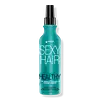What's inside
What's inside
 Key Ingredients
Key Ingredients

No key ingredients
 Benefits
Benefits

 Concerns
Concerns

 Ingredients Side-by-side
Ingredients Side-by-side

Water
Skin ConditioningQuaternium-18
Amodimethicone
Polysorbate 20
EmulsifyingPropylene Glycol
HumectantEthylhexylglycerin
Skin ConditioningMethyl Gluceth-10
EmulsifyingTrideceth-12
EmulsifyingParfum
MaskingIsopropyl Alcohol
SolventPanthenol
Skin ConditioningDisodium EDTA
Cetrimonium Chloride
AntimicrobialCysteine
AntioxidantHydrolyzed Wheat Protein
Skin ConditioningWheat Amino Acids
Skin ConditioningHydrolyzed Wheat Starch
Skin ConditioningAcacia Dealbata Flower Extract
Skin ConditioningGlycerin
HumectantMoonstone Extract
Skin ConditioningCitric Acid
BufferingBenzophenone-4
UV AbsorberPhenoxyethanol
PreservativePotassium Sorbate
PreservativeButylparaben
MaskingEthylparaben
PreservativeMethylparaben
PreservativePropylparaben
PreservativeSodium Benzoate
MaskingCitronellol
PerfumingLimonene
PerfumingLinalool
PerfumingWater, Quaternium-18, Amodimethicone, Polysorbate 20, Propylene Glycol, Ethylhexylglycerin, Methyl Gluceth-10, Trideceth-12, Parfum, Isopropyl Alcohol, Panthenol, Disodium EDTA, Cetrimonium Chloride, Cysteine, Hydrolyzed Wheat Protein, Wheat Amino Acids, Hydrolyzed Wheat Starch, Acacia Dealbata Flower Extract, Glycerin, Moonstone Extract, Citric Acid, Benzophenone-4, Phenoxyethanol, Potassium Sorbate, Butylparaben, Ethylparaben, Methylparaben, Propylparaben, Sodium Benzoate, Citronellol, Limonene, Linalool
Water
Skin ConditioningAloe Barbadensis Leaf Extract
EmollientSimmondsia Chinensis Seed Oil
EmollientEcklonia Radiata Extract
Skin ConditioningParfum
MaskingPhenoxyethanol
PreservativeAmodimethicone
PPG-2 Methyl Ether
PerfumingPEG-40 Hydrogenated Castor Oil
EmulsifyingBenzyl Alcohol
PerfumingPolyquaternium-11
Disodium EDTA
Polysorbate 80
EmulsifyingEthylhexylglycerin
Skin ConditioningAminomethyl Propanol
BufferingCitric Acid
BufferingTrideceth-12
EmulsifyingCetrimonium Chloride
AntimicrobialWater, Aloe Barbadensis Leaf Extract, Simmondsia Chinensis Seed Oil, Ecklonia Radiata Extract, Parfum, Phenoxyethanol, Amodimethicone, PPG-2 Methyl Ether, PEG-40 Hydrogenated Castor Oil, Benzyl Alcohol, Polyquaternium-11, Disodium EDTA, Polysorbate 80, Ethylhexylglycerin, Aminomethyl Propanol, Citric Acid, Trideceth-12, Cetrimonium Chloride
Ingredients Explained
These ingredients are found in both products.
Ingredients higher up in an ingredient list are typically present in a larger amount.
This water-soluble silicone is used for its hydrating and softening properties. It is used to add a silky feel to skincare products and has great benefits for haircare.
In haircare, this ingredient:
- Adds shine
- Protects color
- Offers thermal protection
- Boosts hair strength
- Does not build up as easily
This ingredient is a preservative, antimicrobial, and emulsifier. It is often used in cosmetics for its ability to cleanse, condition, and reduce static.
Cetrimonium chloride is a quaternary ammonium salt, meaning it has a water-soluble structure.
Citric Acid is an alpha hydroxy acid (AHA) naturally found in citrus fruits like oranges, lemons, and limes.
Like other AHAs, citric acid can exfoliate skin by breaking down the bonds that hold dead skin cells together. This helps reveal smoother and brighter skin underneath.
However, this exfoliating effect only happens at high concentrations (20%) which can be hard to find in cosmetic products.
Due to this, citric acid is usually included in small amounts as a pH adjuster. This helps keep products slightly more acidic and compatible with skin's natural pH.
In skincare formulas, citric acid can:
While it can provide some skin benefits, research shows lactic acid and glycolic acid are generally more effective and less irritating exfoliants.
Most citric acid used in skincare today is made by fermenting sugars (usually from molasses). This synthetic version is identical to the natural citrus form but easier to stabilize and use in formulations.
Read more about some other popular AHA's here:
Learn more about Citric AcidDisodium EDTA plays a role in making products more stable by aiding other preservatives.
It is a chelating agent, meaning it neutralizes metal ions that may be found in a product.
Disodium EDTA is a salt of edetic acid and is found to be safe in cosmetic ingredients.
Learn more about Disodium EDTAEthylhexylglycerin (we can't pronounce this either) is commonly used as a preservative and skin softener. It is derived from glyceryl.
You might see Ethylhexylglycerin often paired with other preservatives such as phenoxyethanol. Ethylhexylglycerin has been found to increase the effectiveness of these other preservatives.
Parfum is a catch-all term for an ingredient or more that is used to give a scent to products.
Also called "fragrance", this ingredient can be a blend of hundreds of chemicals or plant oils. This means every product with "fragrance" or "parfum" in the ingredients list is a different mixture.
For instance, Habanolide is a proprietary trade name for a specific aroma chemical. When used as a fragrance ingredient in cosmetics, most aroma chemicals fall under the broad labeling category of “FRAGRANCE” or “PARFUM” according to EU and US regulations.
The term 'parfum' or 'fragrance' is not regulated in many countries. In many cases, it is up to the brand to define this term.
For instance, many brands choose to label themselves as "fragrance-free" because they are not using synthetic fragrances. However, their products may still contain ingredients such as essential oils that are considered a fragrance by INCI standards.
One example is Calendula flower extract. Calendula is an essential oil that still imparts a scent or 'fragrance'.
Depending on the blend, the ingredients in the mixture can cause allergies and sensitivities on the skin. Some ingredients that are known EU allergens include linalool and citronellol.
Parfum can also be used to mask or cover an unpleasant scent.
The bottom line is: not all fragrances/parfum/ingredients are created equally. If you are worried about fragrances, we recommend taking a closer look at an ingredient. And of course, we always recommend speaking with a professional.
Learn more about ParfumPhenoxyethanol is a preservative that has germicide, antimicrobial, and aromatic properties. Studies show that phenoxyethanol can prevent microbial growth. By itself, it has a scent that is similar to that of a rose.
It's often used in formulations along with Caprylyl Glycol to preserve the shelf life of products.
We don't have a description for Trideceth-12 yet.
Water. It's the most common cosmetic ingredient of all. You'll usually see it at the top of ingredient lists, meaning that it makes up the largest part of the product.
So why is it so popular? Water most often acts as a solvent - this means that it helps dissolve other ingredients into the formulation.
You'll also recognize water as that liquid we all need to stay alive. If you see this, drink a glass of water. Stay hydrated!
Learn more about Water